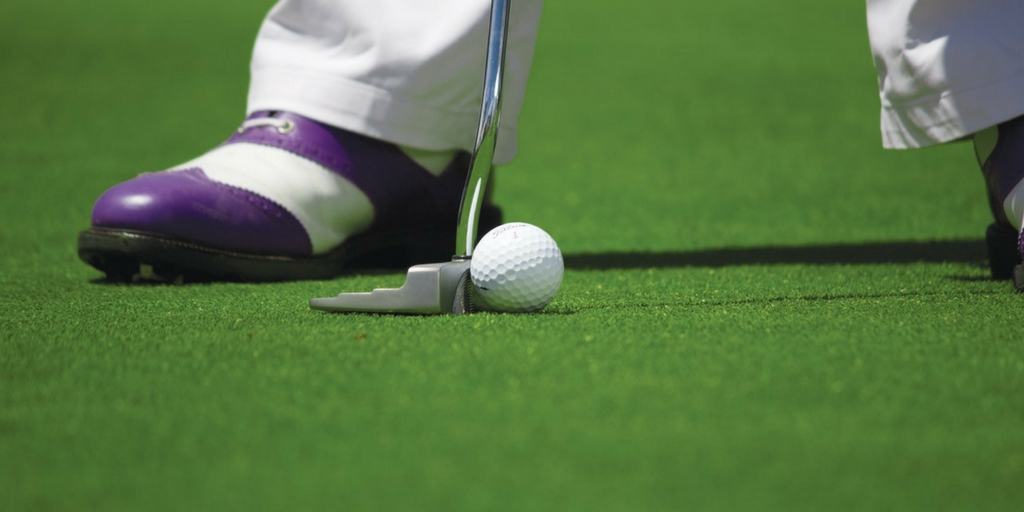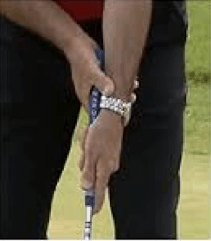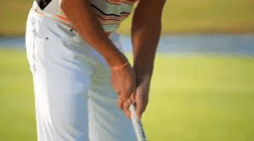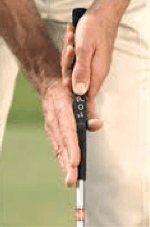
Over the years the grip options for a full golf swing have remained mostly the same. You essentially have three options - the overlapping Vardon grip, interlocking, or the 10-finger option. However, putting grip styles have evolved quite a bit in recent times. In this article, I would like to explore some of the different ways you can grip the putter to make you more successful. My goal is to help you either correct a putting fault or produce more comfort and control on the greens.
My putting strategy is simple. If you're not making putts, don't be afraid to change your technique.
- Louis Oosthuizen
Reverse Overlap - The Traditional Method

Most players are used to this grip. You take the conventional Vardon style of full swing and modify it so that your left forefinger rests on top of the fingers of your right hand.
This was the accepted standard and it was seldom questioned. Many top players today still use this grip. However, this might not be the right putting grip style for you.
The problem that has surfaced over the years is the reverse overlap grip does little to prevent two common faults in the putting stroke - the breakdown of the left wrist, and an overactive right hand. There are many other putting grip styles to try if you experience these faults later in the article.
The Left Wrist Problem
Golfers are taught to hold the angle of their left wrist through impact. If you allow your left wrist to flip, you destroy the true alignment of your putter face to the target.
A popular solution to a twitchy left wrist is to change the relationship of your hands and putt left-hand low. Gary Player stated that if he had to learn golf again, he would use this cross-handed grip for putting.
Bonus Content:Be sure to check out my complete guide to putting.
Bernhard Langer (below) at one time resorted to bracing the putter shaft against the inside of his left forearm, securing it there with his right hand. This is a method still used by Soren Kjeldsen of Denmark.

The Overpowering Right Hand
In the ideal putting stroke, both hands work in unison. However, we are born with a preference for one hand over the other. For right-handed golfers, this means that their right hand is generally stronger than their left.
When you putt with the standard putting grip, you are also more likely to overpower your left hand with your right hand. This is because its position lower down on the shaft makes it more dominant in the stroke.
When your right hand takes over control, it closes your putter face prematurely. Your putts typically will be pulled left on your aim-line (target line). A remedy for this is using an untapered grip that is the same thickness throughout (Super Stroke or Golf Pride Tour Snsr). If you explore this avenue make sure to think about the size of the grip and the placement of your hands.
Now let's take a look at some of the alternative putting grip styles that are used today.
Cross Handed

When standing naturally, every golfer has shoulders that are either open (left shoulder behind right), closed (right shoulder behind left) or square. Most golfers have open shoulders, and the putting setup that best accommodates this anatomical structure is one that features a cross-handed (left-hand-low) putting grip style.
Some websites describe how your putting technique should be determined by your anatomical structure. There are a few ways to determine this. The best is to stand in any doorway with your toes set across the carpet seam. Look left, then right. If your left shoulder is farther behind the door jamb than your right, you have open shoulders.
A second test is to get into your putting stance, allow your hands to hang naturally, then pull your arms together until your hands meet. If your right hand is on your left, again you have open shoulders. To accommodate open shoulders in your setup, use a cross-handed putting grip. With the left hand below the right on the handle, your shoulders will automatically square themselves to the target line, resulting in a straighter putting stroke.
This style takes away both common faults that conventional putting grip styles encounter, with the left hand acting as a deterrent for the right hand to over power. This grip has become more popular today preventing some of the pitfalls of a conventional grip.
Claw

The rule with putting is to do whatever makes the ball find the hole in a manner that can be repeated consistently. There are no rules about sticking primarily to one putting grip style, like using only one type of shot in your long game. Using the grip style that suits the putt might help you have more success.
The Claw grip also takes away two of the common faults seen in a conventional grip. It tends to lock the left wrist in place and controls the right hand from overpowering. The reason behind this is that the right hand is placed underneath the grip between the thumb and index finger. This puts the right hand more on the side of the grip acting in a pushing or brushing motion. With the right hand in this position, it becomes very difficult to twist or turn the putter face producing a more robust and consistent stroke, especially under pressure. There are different styles of claw and the placement of the right hand and of your fingers.
Putting Grip Styles - Experiment and Keep Track of Your Results
There is no right or wrong way when it comes to putting grip styles. If it is comfortable and produces the desired stroke, then go for it!
Whichever grip you decide is right for you make sure you focus quality time practicing it. If you're at home, you could use a practice aid like the Perfect Practice Putting Mat to experiment. It might turn out that the way you originally gripped the club still works best but without exploring your options who knows how good your putting and ultimately score will be.
Also, experimenting with an oversized putting grip might work.
Bonus Content: Check out our putting drills guide
We care about the protection of your data Read our Privacy Policy